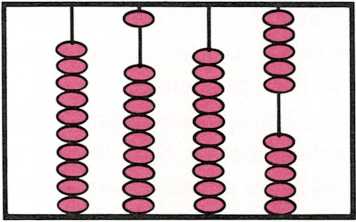

The invention of nothing
One of the most important things ever invented was—nothing!
But how can nothing be important? And how can nothing be invented? To
understand, we have to go back to the abacus.
To show the number 105 on an abacus, you push up one bead in the
hundreds column, no beads in the tens column, and five beads in the ones
column.

1000’s 100’s 1O’s 1’s
If you write this number in Egyptian or Roman numerals, here’s what it
looks like:

In our number system, the order in which the numerals are placed makes a
big difference. The numbers 105 and 501 are not the same. That’s because
the numerals have place value. But in the Egyptian and ancient Roman
systems, there was no place value. The numerals could be in any
order—the number was the same.

We got our number system from the Arabs, who got it from the Hindus of
India. At first, the Hindus had a number system much like other early
number systems. They had many numerals —one for each of the first nine
numbers, as well as for ten, twenty, and so on.
Then, about fifteen hundred years ago, the Hindus did away with all
except the first nine numerals. And they invented a new numeral to stand
for an empty wire on an abacus. They called this numeral sunya, or
“empty.” It was a symbol for nothing. With just nine numerals and
sunya, they could write any numberI
The Arabs picked up this new symbol and introduced it into Europe. We
call the symbol zero, and write it 0. Our word zero comes from the
Arabic word sifr, meaning “empty.”
The invention of the numeral 0 to stand for an empty wire on an abacus
was very important. In a number system that has place value, the 0 acts
as a placeholder. In the number 105, it is the 0 that keeps the 1 in the
hundreds place. And this makes it easy for us to do written arithmetic.

